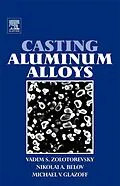Casting Aluminum Alloys summarizes research conducted at Moscow Institute of Steel and Alloy during many decades in part together with Alcoa Inc. The research covered areas of the structure, properties, thermal resistance, corrosion and fatigue of aluminum alloys in industrial manufacturing. - Emphasis on interconnection among phase equilibria, thermodynamics and microstructure of alloys - Systematic overview of all phase diagrams with Al that are important for the development of casting aluminium alloys - Diagrams ("processing windows") of important technological properties such as castability, molten metal fluidity, tendency to hot pre-solidification cracking, porosity - Mathematical models for alloy mechanical properties facilitating the down-selection of best prospect candidates for new alloy development - New principles of design of eutectic casting aluminium alloys - Examples of successful novel casting alloy development, including alloys for high-strength applications, alloys with transition metals, and novel alloys utilizing aluminium scrap
Autorentext
Dr. Glazoff holds three doctorate degrees: Materials Science and Engineering; Chemistry, and in the spring of 2015 completed his doctorate in Nuclear Engineering from the University of Idaho. He has been involved for over 17 years in the R & D industry, as well as having held a number of academic positions.
Klappentext
Casting Aluminum Alloys summarizes research conducted at Moscow Institute of Steel and Alloy during many decades in part together with Alcoa Inc. The research covered areas of the structure, properties, thermal resistance, corrosion and fatigue of aluminum alloys in industrial manufacturing.
- Emphasis on interconnection among phase equilibria, thermodynamics and microstructure of alloys
- Systematic overview of all phase diagrams with Al that are important for the development of casting aluminium alloys
- Diagrams ("processing windows") of important technological properties such as castability, molten metal fluidity, tendency to hot pre-solidification cracking, porosity
- Mathematical models for alloy mechanical properties facilitating the down-selection of best prospect candidates for new alloy development
- New principles of design of eutectic casting aluminium alloys
- Examples of successful novel casting alloy development, including alloys for high-strength applications, alloys with transition metals, and novel alloys utilizing aluminium scrap
Inhalt
Introduction, List of Symbols and Abbreviations, 1. Alloying Elements and Impurities: Phase Diagrams, 2. Structure of Aluminum Alloys in As-Cast Condition, 3. The Role of Heat Treatment in Microstructure Formation of Aluminum Alloys, 4. Composition and Microstructure Dependence of Casting and Mechanical Properties of Aluminum Alloys, 5. Industrial Alloys, 6. Novel Casting Alloys,Literature, Appendix 1 Compositions of Principal Casting Alloys (Nomenclature of Aluminum Association), Appendix 2 Binary Phase Diagrams Important for Understanding Aluminum Alloys, Appendix 3 Guaranteed Levels of Mechanical Properties of Casting Alloys, Appendix 4 Recommended Heat Treatments for Casting Aluminum Alloys, Appendix 5 Data on Fracture Toughness, UST, YS, Fatigue Properties, Thermal Resistance, Corrosion Resistance and Castability of Al-Si Based Casting Alloys, Appendix 6 Analysis of Uniaxial Tensile Deformation Testing Data Using the Mechanics of Finite Deformations
